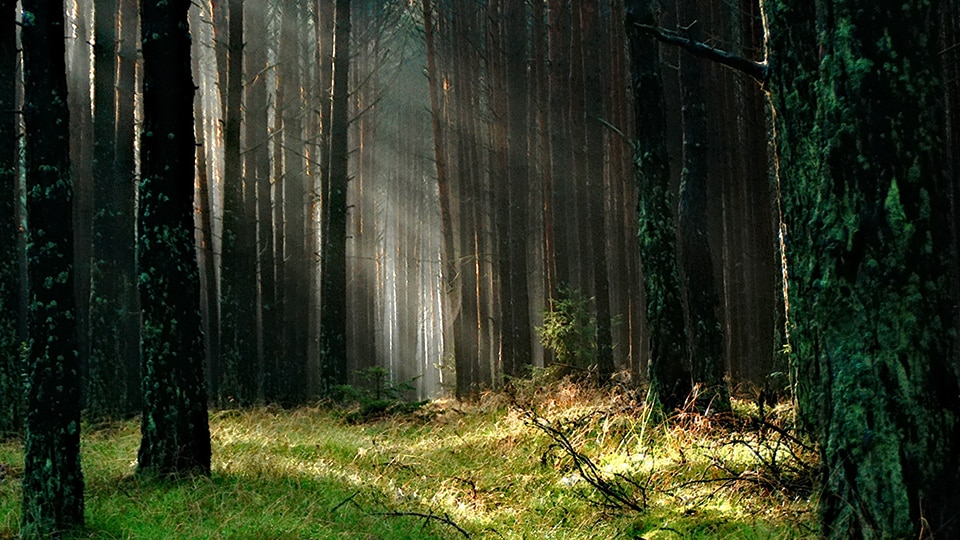We depend on forests so much. The landscape inspires us. We turn the timber we harvest into both beautiful and practical things - the homes we live in, the tools we use, and yes, the guitars we play. We also depend on forests to clean the air we breathe, purify the water we drink, and regulate our climate. Here, we start to see the conflict: when we overharvest our forests, even when it is to build the things we need and love, we have a negative impact on our ecosystems. Most guitars, both vintage and modern, are made of wood, and not just any wood. Many guitars are made of specific, close-grained, dense woods known as tone woods. Tone wood often comes from old-growth forests and from slower-growing varieties of trees. These dense, rare woods like ebony and rosewood, which frequently appear as fretboards because of their beauty and durability, are becoming increasingly threatened. Some wood varieties, like Brazilian Rosewood, are so endangered that any use of them in modern instrument construction is forbidden.
It's easy to recognize the need for action in a quickly changing world to save our forests and our climate. But what can you do to help?
![[RS+] - All About the Green Game Jam - moodyforest](http://staticctf.ubisoft.com/J3yJr34U2pZ2Ieem48Dwy9uqj5PNUQTn/4792nNNTqvlaAfcC8voPTg/6326d8add6f579b8301739d11f73f510/moodyforest.jpg)
Choose better materials.
First, consider the materials the guitar is made of when making a new purchase. Many luthiers - that is, professional guitar builders - are aware of and concerned about the impact their work has on forests around the world. Many have produced ingenious solutions to the problem. Some have gravitated to other wood varieties with equivalent properties to the endangered ones.
![[RS+] - All About the Green Game Jam - tonewoods](http://staticctf.ubisoft.com/J3yJr34U2pZ2Ieem48Dwy9uqj5PNUQTn/4cllXhZOsKsJLC4S1IEXCg/56848350f07a7e0df2bf83416b42ec2d/tonewoods.jpg)
Different woods have different uses. Lighter woods like spruce are popular for soundboards, and denser tone woods often appear as the back and sides of acoustic guitars.
Look for beautiful alternatives that grow quickly, sequester more carbon as they grow, and are easy to transport like koa, sitka spruce, western red cedar, ash, maple, and basswood. The good news is that many of these woods are commonplace in guitar manufacturing already, so you don't have to search too hard to find a beautiful guitar with less of an environmental impact.
![[RS+] - All About the Green Game Jam - Carbon fibre weave](http://staticctf.ubisoft.com/J3yJr34U2pZ2Ieem48Dwy9uqj5PNUQTn/4t24FGJKGYV0GPlIMnIY4h/c575c7f32fc30b9794545c0d8900f5cb/Carbon_fibre_weave.jpg)
Builders sometimes use unconventional materials like carbon fiber to make instruments that are very durable, and even waterproof.
Many builders - including many of the larger instrument companies - have committed to reducing or eliminating their use of certain threatened tone woods in their guitars. When in doubt, you can check to see if a manufacturer's website lists such a commitment.
Maintain your instruments and make repairs when needed.
You can do a lot more to maintain your guitar or bass than you might think. To start, keep it clean and away from extreme temperatures and fluctuations in humidity. If you play an acoustic, keep track of the air quality in your home and use a room or in-case humidifier if it gets too dry (this helps to prevent cracks in the wood). If damage does occur, see if you can get it fixed. You would be surprised what a skilled luthier can do to mend a cracked soundboard, or even reattach a snapped-off headstock. Your prized instrument can still look and play like new after an injury and does not need to be replaced.
![[RS+] - All About the Green Game Jam - guitarsoundhole](http://staticctf.ubisoft.com/J3yJr34U2pZ2Ieem48Dwy9uqj5PNUQTn/2XM0RMEzLYYA1sDNtLTs7t/3e935a17d8e0f4de2ce799cde1c32a92/guitarsoundhole.jpg)
Be sure to humidify your acoustic guitar if you experience dry weather.
Think about the life cycle of the instrument you play.
Just like buildings, bridges, and vehicles (to name a few), instruments have lifespans, beyond which they become too fragile (or too priceless) to play regularly. For a sturdily built guitar or bass this can take a long time, even turning into a vintage or heirloom piece, but one day the materials it is made from may start to weaken, turn brittle, or rot. Sometimes, as mentioned above, it's possible to make repairs. Other times, less so. Think about the durability of an instrument compared with its ability to return to the earth when making your selection.
![[RS+] - All About the Green Game Jam - hardwoodforest](http://staticctf.ubisoft.com/J3yJr34U2pZ2Ieem48Dwy9uqj5PNUQTn/364fdfa8WS6n4ffZh7q0K6/1a23cf057ae76db23a6e7b89daa8a93e/hardwoodforest.jpg)
Many tone woods come from old growth forests like this.
Participate in reforestation efforts.
It's a simple enough concept: replenish what you take. Especially in the case of fast-growing, carbon-sequestering wood varieties, planting new forests can offset the impact of guitar building and even recapture some of its carbon emissions. One way you can get involved today is to participate in the Green Game Jam with Rocksmith+. The Green Game Jam is an initiative within the gaming industry to educate, organize, and work for environmental change. Rocksmith+'s entry to this project, called "Tonewood," does exactly that. When you play Rocksmith+ you can show your support by learning about green best practices along with us, using our beautifully designed guitars in our app, and playing along with green-themed tunes in our music library. When you participate, you can learn more about the need for reforestation, and as you learn Rocksmith+ will donate funds to plant new trees.
Find out more at the Green Game Jam website.
Margaret Jones is a multi-instrumentalist, songwriter, and music teacher living in Oakland, CA. She plays guitar in several local bands including her own songwriting project M Jones and the Melee. She also holds a Ph.D. in Music History from UC Berkeley and has taught at the San Francisco Conservatory of Music.
"Forest With Sunlight" by Pixabay is licensed under Creative Commons Zero.
"Wyrocznia"* by*Kamil Sypień* is licensed under CC0 1.0.*
"TGFT14 body top - Taylor Guitar Factory"* by Marcin Wichary is licensed under CC BY 2.0.*
"Carbon fibre weave"* by Christine Twigg is licensed under CC BY-SA 4.0.*
"Music, wood, guitar"* by Pxhere is licensed under *Creative Commons Zero.
"Northern Hardwood Forest"* by Nicholas A. Tonelli is licensed under CC BY 2.0.*









